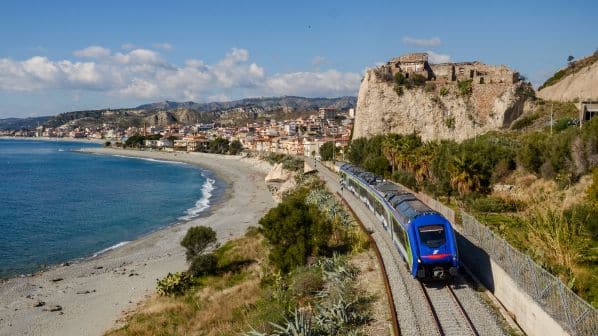Projects
WITH around 50 major projects in the pipeline, including 20 currently under construction, the full spectrum of rail development can be found in Italy, ranging from cross-border high-speed lines to metro and light rail extensions.
The flagship scheme is undoubtedly the 270km $US 27bn Turin - Lyon cross-border high-speed passenger and freight line, 70% of which is in France and 30% in Italy. Around 80% of the capacity of the line will be used by freight trains.
Construction finally started in 2018 on the controversial project, which has faced determined opposition from environmental campaigners, who particularly oppose the excavation of the Mont Cenis Base Tunnel.
Construction of the €8.6bn 65km cross-border section of the new line is underway from Susa to Saint-Jean-de-Maurienne, of which 57.5km consists of the Mont Cenis Base Tunnel. The Franco-Italian company Tunnel Euralpin Lyon Turin (Telt) is responsible for this section and announced the start of main tunnelling work in Italy at the end of last year.
Infrastructure manager Italian Rail Network (RFI) is responsible for the Italian part from Bussoleno in the Susa Valley to Turin, while SNCF Network is leading the French section from Saint-Jean-de-Maurienne to Lyon. Construction of these two sections, which have another 104.5km of tunnels, is well underway. Completion of the entire line is scheduled for 2030.
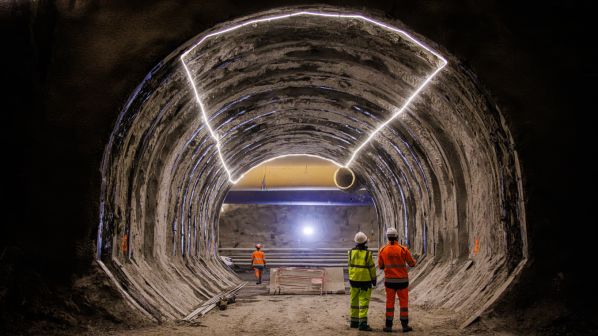
Forming part of the Trans-European Transport Network (TEN-T), the new line will help relieve pressure on cross-border roads, where lorry traffic has doubled over the last 30 years, and will help to double freight train capacity to up to 1500 tonnes. Passenger journey times will also be significantly reduced.
When complete the Mont Cenis Base Tunnel is likely to achieve the accolade of the world’s longest rail tunnel, taking the title from the current record holder, the 57.1km Gotthard Base Tunnel. But it is unlikely to hold on to it long, as another project snapping at its heels, the 64km Brenner Base Tunnel, also currently under construction, will take that prize, possibly as early as 2032.
The Brenner Base Tunnel is expected to cut journey times by 69% and increase freight capacity by 50% on the Verona - Innsbruck route, forming part of the TEN-T Core Corridor 5 linking the Mediterranean with Scandinavia.
A key milestone in the project, completion of four 60m tunnel bores under the Isarco River on the southern approach to the base tunnel, was achieved last summer.
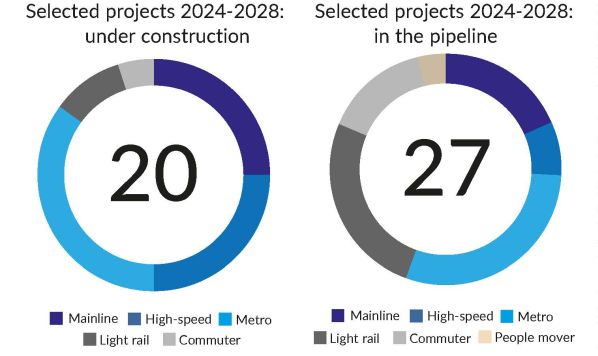
While much of Italy’s core high-speed network is complete, a number of projects are planned to develop new routes and connections. Last summer RFI awarded the Iricav Due consortium a €1.82bn contract to undertake the design and construction of the section through Vicenza of the new 76.4km high-speed/high-capacity (HS/HC) line between Verona and Padua.
The section awarded to the Iricav Due consortium, the second of three lots on the new Verona line, runs for 6.2km from the town of Altavilla Vicentina to Vicenza station. It also includes the renewal of 4.8km of the existing line. This will allow for an increase in high-speed, regional and freight services along the Milan - Venice line, boosting capacity and punctuality, reducing journey times and increasing frequency.
In southern Italy a consortium of Webuild, Ghella and Impresa Pizzarotti is working on a €2bn contract to construct 35km of the new Salerno - Reggio Calabria 300km/h high-speed line between Battipaglia and Romagnano. The project involves the boring of around 14km of tunnels, building more than 6km of viaducts and nearly 5km of cut and cover tunnels. There will also be a junction built at Romagnano to connect with the existing Battipaglia - Metaponto - Potenza line.
Also in southern Italy, tunnelling work started last year on Telese - Vitulano section of the Naples - Bari HS/HC line. The project also involves track doubling, upgrading and partial realignment of the existing 30km conventional line between Frasso Telesino and Vitulano. Four new stations are planned at Amaorosi, Solopaca, San Lorenzo and Ponte Casalduni, while the existing station at Telese will be rebuilt.
The entire line, which is scheduled for completion in 2027, will improve the connectivity of the southeastern Puglia region with the provinces of Campania and with the Milan - Rome - Naples HS/HC line.
Work is currently underway at Trento, after RFI last year awarded a consortium led by Webuild a contract worth €934m to build a 13km largely underground bypass. The contract includes the construction of a 10.6km tunnel and two short sections above ground alongside the existing line and was awarded as part of widening the Fortezza - Verona high-speed line to four tracks. It will form part of the southern access route to the Brenner Base Tunnel.
Mainline projects
Aside from development of the high-speed network, other key mainline projects are underway, such as the Bergamo Hub. Construction started in February on a new station and integrated transport facility in the heart of Bergamo. The €460m project also includes the doubling of the existing line between Bergamo and Ponte St Pietro, a new station at Curno and construction of a new 5.3km double-track line to Bergamo-Orio Al Serio airport. Completion is scheduled for 2026.
Off the mainland, construction is progressing on the new 250km/h main line between Palermo and Catania on the island of Sicily. RFI awarded the final contract worth €1.3bn, for the 178km route to a consortium of WeBuild and Ghella last summer.
The work involves the construction of a 30km double-track line, of which approximately 20km will be in tunnels, from Fiumetorto, on the existing Palermo - Messina main line, south to Lercara. The project includes the construction of a new station at Cerda, a connection with the Termini Imerese Interport intermodal terminal and Valle del Torto, as well as the redevelopment and upgrade of Lercara Diramazione station, which will improve connections with Agrigento.
When complete in 2029 the new Palermo - Catania line will form part of the TEN-T network’s Scandinavian - Mediterranean Corridor and is designed to cut the journey time between Palermo and Catania by 60 minutes to two hours.
Last autumn the Italian government approved funding for several metro and light rail projects, including:
- a total of €221.7m for the extension of Turin’s light rail Line 12 to Allianz Stadium and for work on the Turin - Ceres line
- €74.5m to Genoa for the extension of the light metro north to Rivarolo and the completion of Martinez station on the line’s eastern extension, and
- €650m for a 10.6km extension to the Catania light metro in Sicily. This involves extending the standard-gauge light metro northwest from Misterbianco through the Ardizzone tunnel to Paternò. The extension will have four intermediate stations at Giaconia, Belpasso, Valcorrente and Gullotta. The light metro is already being extended from Nesima to Misterbianco.
Work started last summer on the construction of Venezia station on Rome Metro Line C, the city’s first driverless metro. The new station is part of a 7km extension of the 19km route between Montecompatri/Pantano in the eastern suburbs and San Giovanni near the city centre. Construction of new stations at Porta Metronia and Colosseo/Fori Imperiali is well advanced, with both scheduled to be completed in the second half of this year.
Design work is underway for a further extension from Venezia towards Clodio/Mazzini with another four stations, while a further extension from Clodio to Farnesina with two more stations is proposed.
Fleet
PRIDE of place in Italy’s rolling stock fleet are the high-speed trains operated by Trenitalia and competing private operator NTV. Last year Trenitalia committed to updating its fleet by signing an €861m contract with Hitachi Rail for 30 new ETR 1000 high-speed trains. The contract includes an option for a further 10 trains for an additional €287m.
The 200m-long four-voltage trains, each with capacity for 460 passengers, will be built in Naples and Pistoia and are due for delivery between 2026 and 2029. They will predominantly be used on the Italian high-speed network, although they will be equipped with signalling systems and certified to operate on high-speed lines in France, Germany, Spain, Austria, Switzerland, Belgium and the Netherlands. Trenitalia has confirmed plans to operate new cross-border services to Munich and Ljubljana using the new fleet in recent weeks.
As elsewhere in Europe, Italian operators are embracing alternative types of traction. Last July orders were placed for the world’s first narrow-gauge hydrogen multiple-units. The new trains, built by Stadler, will run on the 950mm-gauge networks in Sardinia and Calabria.
Sardinian Regional Transport Company (ARST) and Calabria Railways (FdC) both signed framework agreements with the Swiss manufacturer for the supply and maintenance of a total of 25 two-car trains, 15 for FdC and 10 for ARST. Both operators will receive six trains each under the initial orders within the framework contracts.
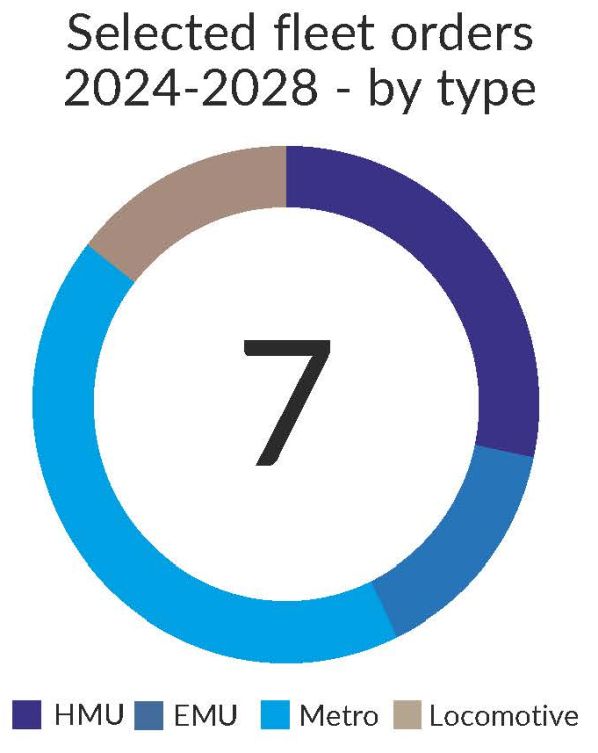
The 50m-long aluminium-bodied fully-accessible trains, to be built at Stadler’s Bussnang plant in Switzerland, will each have 89 seats and capacity for a total of 155 passengers, and are due for delivery in 2026.
At the start of this year FdC called off a further three units from the framework order and says the new trains, plus other projects currently underway, including infrastructure upgrades and the construction of a hydrogen production plant, form part of the railway’s strategy to become a modern and sustainable public transport company within the next three years. It says it is investing more than €400m to become a leader in regional transport and to provide more services to users.
Another first took place in October, when Alstom delivered its first hydrogen-powered Coradia Stream train to an Italian operator. It will enter commercial service in Valcamonica between the end of this year and the start of next, on the non-electrified Brescia - Iseo - Edolo line, operated by Trenord on behalf of fleet owner FNM.
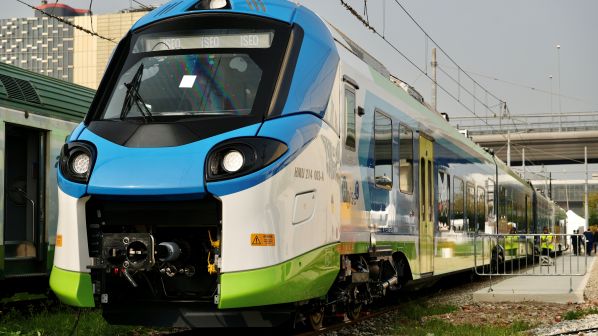
The train is the first of six units that formed the initial order of a framework contract awarded by FNM to Alstom in November 2020, with includes an option for eight more. The train seats 260 passengers and has a range of more than 600km.
The new trains form part of the H2iseO project, aimed at creating Italy’s first Hydrogen Valley in the Brescia area. H2iseO will develop a hydrogen supply chain in Valcamonica, starting with the transport sector, by decarbonising a significant part of local public transport through the use of hydrogen-powered trains and buses. Three plants will be built in Brescia, Iseo and Edolo for the production, storage, and distribution of renewable hydrogen without CO₂ emissions.
Tri-mode trains
Last July, Hitachi Rail completed the first batch of 20 tri-mode trains under a €1.23bn framework contract with Trenitalia for 135 trains. Hitachi has a firm order for 98 trains so far in a mixture of three and four-car sets.
The trains, branded Blues by Trenitalia, can run powered by OHLE (3kV dc), diesel or batteries for up to 15km. They can operate at a maximum speed of 160km/h in conventional electric or diesel mode, but only 100km/h under battery power.
Hitachi is developing a bi-mode version of the train where the diesel engine will be replaced with a more powerful lithium titanate oxide (LTO) battery with a capacity of 132kWh - 500kWh. This would extend the range of the train to around 100km with a full load of passengers and Hitachi claims a full charge from the OHLE can be achieved in 10 minutes.

The manufacturer says that there is flexibility in the framework deal with Trenitalia to substitute some of the tri-mode Blues trains for the new bi-mode version. The train is also designed so that tri-mode trains can be converted to bi-mode operation if desired.
A framework agreement for traditional EMUs has been signed by Naples regional public transport operator EAV and Stadler for the supply of up to 60 1.5kV dc 950mm-gauge three-car trains, including a first call for 16 EMUs and associated maintenance for five years.
The new 40m-long trains can accommodate 396 passengers and will operate regional services on the 142km, six-line Circumvesuviana network that serves suburbs to the east of Naples and Sorento. Delivery is expected in 2026.
This order is an addition to a framework agreement for 40 three-car trains awarded to Stadler in March 2021. That contract included an initial order for 23 trains. The option for the remaining 17 was exercised in July 2022.
Several metro and light rail fleet orders for a number of Italian cities have recently been made or completed, including:
- the supply of six six-car metro trains by CAF for Naples regional public transport operator EAV, part of a framework contract for 10 trains to operate on the Piscinola/Scampia - Aversa line and eventually on the metro line which will run from Piscinola via Miano, Secondigliano and Capodichino Airport to connect with Line 1 at Garibaldi
- the supply of nine LRVs by CAF for Palermo, with an option for a further 35
- the supply of up to 50 Stadler Tramlink LRVs, comprising up to 25 medium-capacity and 25 high-capacity variants for Milan Transport (ATM) under a framework agreement that includes an initial order for 14 35m-long high-capacity vehicles, to be built at Stadler’s plant in Valencia, Spain, and delivered by 2026. The medium-capacity three-section Tramlink LRV is 25m long, and will be similar to the LRVs that Stadler is delivering to ATM under a framework for up 80 signed in 2020. ATM has placed orders for 60 LRVs under this earlier framework, the first of which arrived in Milan on December 1 2022, and
- the entry to service last September of the first 30 new Hitachi LRVs for Turin Transport Group (GTT) which signed a framework contract for 70 LRVs in Spring 2020. The remaining batch of 40 28m-long vehicles, which have a maximum speed of 60km/h and can accommodate up to 218 passengers, should be delivered to Turin this year.
The revival of overnight trains across Europe resulted in Trenitalia signing a €732.5m framework contract last August with a consortium of Škoda Group and Titagarh Firema for up to 370 new sleeping cars.
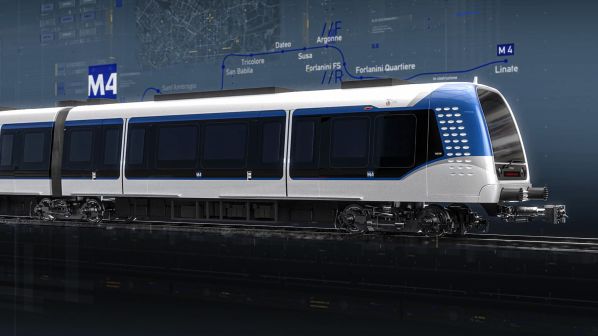
The initial order, worth €138.6m, is for 70 vehicles. This consists of 40 Comfort coaches, 22 DeLuxe and four Economy vehicles. The new coaches, all of which are to be equipped with air-conditioning and modern passenger information systems, will be deployed on the Milan - Palermo/Syracuse line.
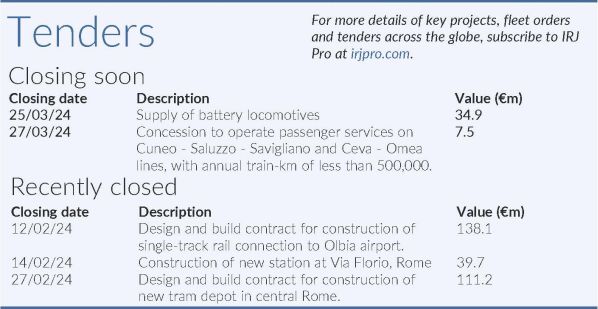
The DeLuxe vehicles each offer six single and two double bedrooms, with their own toilet and shower.
The Comfort coaches each feature seven compartments fitted with four beds and a washbasin. Each compartment is equipped with air-conditioning. The coaches have larger areas to accommodate passengers with reduced mobility including accessible toilets.
The Economy coaches offer a 2+1 seating arrangement, with privacy walls between sections in each vehicle. They also feature armrests, oversized headrests and individual lighting at each seat. The vestibule area contains luggage racks and a toilet.
The coaches will be built at Titagarh Firema’s plant in Caserta, Campania. Procurement is supported by funding from Italy’s National Recovery and Resilience Plan (PNRR).
